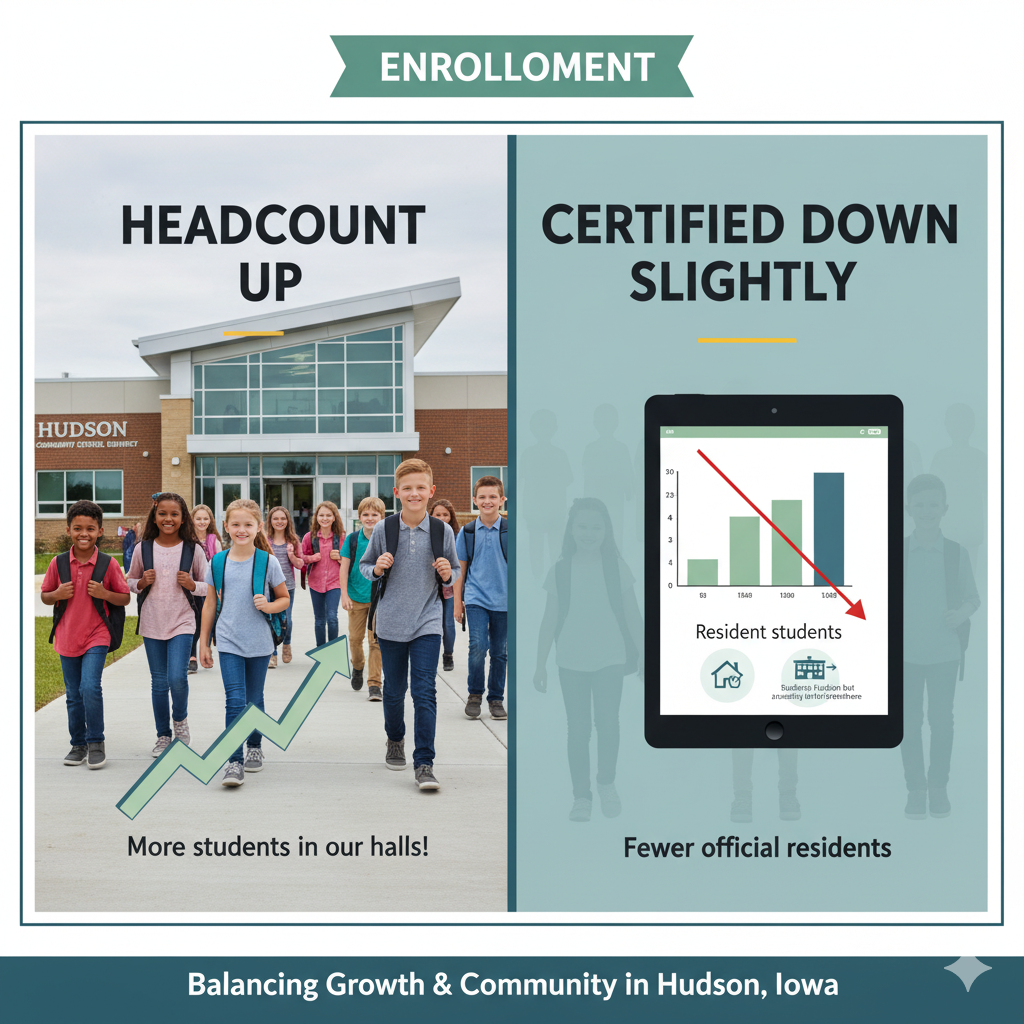Enrollment: Headcount Up; Certified Down Slightly

By Superintendent of Hudson Community School District, Dr. Anthony Voss
October is a very busy month for school administrators in Iowa, as a plethora of state reporting occurs. None may be more important than certifying our enrollment. October 1 is the Official Count Day, and that is the day we take a census of the number of students we have in our school district. This enrollment census is critical because it provides the first key variable necessary for budgeting the 2026-2027 school year. Once we have taken that count on October 1, the following two weeks are used to reconcile those numbers with other school districts, ensuring students who are open enrolled, attending private schools, or who are homeschooled are property accounted for. Today then, October 15th is the date those numbers are certified with the state. To view the complete report, please follow this link.
When considering preschool through twelfth grade enrollment, the district is currently serving 924 students, which is slightly less than last year. Kindergarten through twelfth grade enrollment on October 1 was 877 students, which was less than projected through a student conducted by RSP and Associates. That study predicted enrollment would be 893. Although this difference is notable, the headcount, or number of students attending Hudson School is up
8 students from last year at the same time period. Up is good, but this less than expected and could be indicative of a softening economy.
Certified enrollment describes students with a physical address of Hudson and includes students who attend school in Hudson or open enroll to another public-school district. Our certified number is down 8.54 students from last year. The basic calculation is the number of resident students attending in the local district, plus the number of resident students attending another public-school district. The BEDS count, on the other hand considers students who are served in the school district. The basic calculation here is resident students attending our school district, plus those who are open enrolled into Hudson. In this case, there is a net increase of 5.10 students over last year from 876.64 to 881.74, or a .58% enrollment increase. This is less than expected.
The number of students open enrolling out of Hudson has also increased from 69 to 73 with just over half choosing Cedar Falls (33). The second spot belongs to a host of online options, with (13) Hudson residents attending those programs, followed by (12) in Gladbrook Reinbeck. There are 185 students open enrolling into Hudson, compared to 170 from a year ago. Waterloo continues to lead, with (117) students open enrolling into Hudson, up from (114) a year ago. Our data suggests (11) students taking advantage of the ESA program, up from (5) one a year ago. The primary takeaway is that a net positive of 113 students (those open enrolled in minus those open enrolled out) is a very good sign for the district.
We had 41 students who were enrolled last year but have subsequently transferred out or moved to another school district. This compares to 39 students who moved out last year and would suggest a more transient population of learners.
Elementary grade levels remain the largest, with 4 sections per grade level from grades K-3. Even while considering a slight dip in enrollment this current year, the district anticipates a four-section grade level pattern to continue matriculating across the district. Even so, a deliberate decision has been made to cap open enrollment. This is being done purposefully in order to accommodate the increase in resident ‘attending’ students. The strategy being employed will be to counterbalance residential enrollment with open enrollment. As residential enrollment increases, open enrollment will decrease; which is illustrated in this report. While the challenges of staffing remain real, the fact is that residential enrollment growth will undoubtedly add additional strain to our system.
Enrollment projections used in this study are calculated based on a cohort methodology that uses a five-year rolling average to determine kindergarten size. Over the last 5 years, the kindergarten has averaged 76 students; while in the last 10 years it has averaged 65.5. Based on both residential enrollment growth coupled with open enrollment, a projection of 76 seems to be right, particularly since open enrollment from Waterloo is not anticipated to drop off. With
this methodology, estimates from prior years are left static since there is no algorithm to accurately predict transfers in or out of the district. If these projections were come to fruition, we will reach a current high-water mark of 970 in 2030-2031.
However, during the last school year, the school district contracted with RSP and Associates to conduct an enrollment study for the school district. As mentioned in the opening paragraph, this estimation was slightly off what was predicted. Yet, it is important to note the RSP work suggest K-12 enrollment topping 1,011 during the 2029-2030 academic year. This should not be interpreted as one model being superior to the other, but they instead should be viewed as complementary instruments that utilize different methodologies. While this analysis is markedly different from the cohort methodology deployed by today's report, both models suggest rapid enrollment growth; particularly evidenced by smaller class sizes graduating from high school and larger class sizes entering kindergarten. To compare the results of both reports, please visit the 'About Us' section of our website.



Comments ()